Abstract
A study was conducted to determine effects of using two different methods of approximating the growing season (GS) on the hydrology of lands that satisfy the wetland hydrologic criterion. The two GS considered were the frost-free GS defined by medium dates of 28 °F air temperatures (28F), and a 365-day GS (365D) based on soil temperature. Analyses on 5 hydric soils near Plymouth, NC showed that using the 365D rather than the 28F GS will substantially reduce saturation requirements for wetland hydrology. A site that would have a water table within 30 cm of the surface for a continuous period of 14 days or more in 50 % of the years during a 365D GS would satisfy the same criterion for only 4 % of the years during the 28F GS; it would have water table less than 30 cm deep for a continuous period of only 7 days in 50 % of the years during the 28F GS. Use of the 365D rather than the 28F GS would substantially reduce saturation requirements at the wet end of the wetland hydrology spectrum (12.5 % of GS) which is typically required for wetland restoration in mitigation projects. Research is needed to develop a scientifically rigorous criterion for wetland hydrology.






Similar content being viewed by others
References
Bedford BL (1996) The need to define hydrologic equivalence at the landscape scale for freshwater wetland mitigation. Ecol Appl 6(1):57–68
Burdt AC, Galbraith JM, Daniels WL (2005) Season length indicators and land-use effects in southeast Virginia wet flats. Soil Sci Soc Am J 69:1551–1558
Caldwell PV, Vepraskas MJ, Skaggs RW, Gregory JD (2007) Simulating the hydrology of natural Carolina Bay wetlands. Wetlands 27(4):1112–1123
Caldwell PV, Vepraskas MJ, Skaggs RW, Gregory JD, Huffman RL (2011) Linking plant ecology and long term hydrology to improved wetland restoration success. Trans ASABE 54(6):2139–2137
Ehrenfeld JG, Cutway HB, HamiltonIV R, Stander E (2003) Hydrologic description of forested wetlands in northeastern New Jersey, USA–an urban/suburban region. Wetlands 23(4):685–700
Faulkner SP, Patrick WH Jr, Gambrell RP, Parker WB, Good BJ (1991) Characterization of soil processes in bottomland hardwood wetland-nonwetland transition zones in the lower Mississippi River Valley. Report WRP-91-1. US Army Engineer Waterways Exp. Station, Vicksburg, MS, p 175
Federal Register (1994) Changes in hydric soils of the United States, vol 59. U.S Gov Print Office, Washington, D.C.
He X, Vepraskas MJ, Skaggs RW (2002) Adapting a drainage model to simulate water table levels in coastal plains soils. Soil Sci Soc Am J 66:1722–1731
He X, Vepraskas MJ, Linbo DL, Skaggs RW (2003) A method to predict soil saturation frequency and duration from soil color. Soil Science Society of America J 67:961–969
Hunt, WF III, Skaggs RW, Chescheir GM, Amatya DM (2001) Examination of the wetland hydrologic criterion and its application in the determination of wetland hydrologic status. Report No 333, Water Resources Research Institute of the University of North Carolina, 119 p.
Kazezyilmaz-Alhan CM, Medina MA Jr, Richardson CJ (2007) A wetland hydrology and water quality model incorporating surface water/groundwater interactions. Water Resour Res 43(W04434):1–16
Luo W, Skaggs RW, Chescheir GM (2000) DRAINMOD modifications for cold conditions. Trans ASAE 43(6):1569–1582
Megonigal JP, Faulkner SP, Patrick WH (1996) The microbial activity season in southeastern hydric soils. Soil Sci Soc Am J 60:1263–1266
Miller WL, Bragg AL (2007) Soil characterization and hydrological monitoring project, Brazoria County, Texas, bottomland hardwood Vertisols. USDA, NRCS, Temple
NRC (1995) Characteristics and Boundaries. National Research Council Committee on Characterization of Wetlands. National Academy Press, Washington D.C, p 307p
Phillips BD, Skaggs RW, Chescheir GM (2010) A method to determine lateral effect of a drainage ditch on wetland hydrology: field testing. Trans ASABE 53(4):1087–1096
Seybold CA, Mersie W, Huang J, McNamee C (2002) Soil redox, pH, temperature, and water-table patterns of a freshwater tidal wetland. Wetlands 22:149–158
Skaggs, RW (1978) A water management model for shallow water table soils. Rep. 134. Water Resources Research Inst. of the UNC,, NC State University, Raleigh. 128 pp.
Skaggs RW (1999) Drainage simulation models. In: Skaggs RW, van Schilfgaarde J (eds) Agricultural Drainage. SSSA, Madison, pp 469–500
Skaggs RW, Amatya D, Evans RO, Parsons JE (1994) Characterization and evaluation of proposed hydrologic criteria for wetlands. J Soil and Water Conser 49(5):501–510
Skaggs RW, Chescheir GM, Phillips BD (2005) Methods to determine lateral effect of a drainage ditch on wetland hydrology. Trans ASAE 48(2):577–584
Tweedy KL, Evans RO (2001) Hydrologic characterization of two prior converted wetland restoration sites in eastern North Carolina. Trans ASAE 44(5):1135–1142
USACE (U.S. Army Corps of Engineers) (1987) U.S. Army Corps of Engineers Wetlands Delineation Manuel. Environmental Laboratory, U.S. Army Engineer Waterway Exp. Station Tech. Report Y-87-1
USACE (U.S. Army Corps of Engineers) (2005) Technical standard for water-table monitoring of potential wetland sites. Environmental Laboratory, ERDC TN-WRAP-05-2
USACE (U.S. Army Corps of Engineers) (2010) Regional supplement to the Corps of Engineers wetland delineation manual: Atlantic and Gulf Coastal Plain Region (Version 2.0). U.S. Army Corps of Engineers Environmental Laboratory, ERDC/EL TR-10-20
van der Ploeg RR, Horton R, Kirkham D (1999) Steady flow to drains and wells. In: Skaggs RW, van Schilfgaarde J (eds) Drainage for Agriculture, Monograph No.38. American Society of Agronomy, Madison, pp 213–263
Vepraskas MJ, He X, Lindbo DL, Skaggs RW (2004) Calibrating hydric soil field indicators to long-term wetland hydrology. Soil Sci Soc Am J 68:1461–1469
Winter TC (1988) Conceptional framework for assessment of cumulative impacts on the hydrology of non-tidal wetlands. Environ Manag 12:605–620
Winter TC (1989) Hydrologic studies of wetlands in the northern prairie. In: van der Valk A (ed) Northern Prairie Wetlands. Iowa State University Press, Ames, pp P16–P54
Zhang L, Mitsch WJ (2005) Modeling hydrological processes in created freshwater wetlands: an integrated system approach. Environmental Modeling and Software 20:935–946
Author information
Authors and Affiliations
Corresponding author
Rights and permissions
About this article
Cite this article
Skaggs, R.W. Effect of Growing Season on the Criterion for Wetland Hydrology. Wetlands 32, 1135–1147 (2012). https://doi.org/10.1007/s13157-012-0344-2
Received:
Accepted:
Published:
Issue Date:
DOI: https://doi.org/10.1007/s13157-012-0344-2




